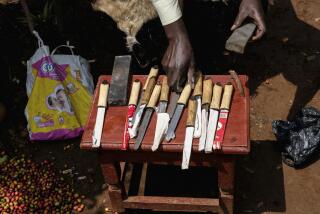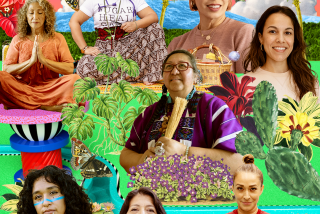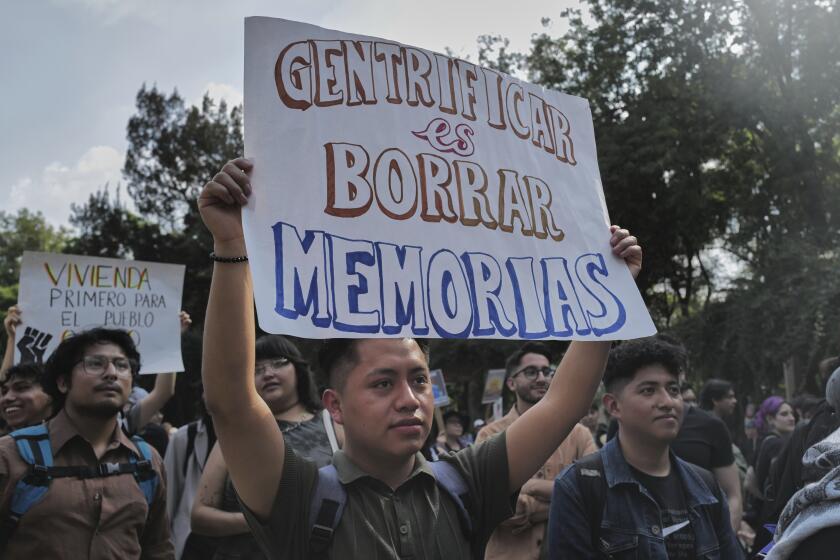African Healers Expand Repertoire in Medical Care
- Share via
KAMPALA, Uganda — Mutebi Moses Tokamalirawo doesn’t look like an African traditional healer, at least not the skin-clad, wild-eyed witch doctors of Western bias.
Trim and easy moving at 50, with mutton-chop sideburns, an untucked shirt and green pants hanging over beach sandals, he gently tickles toddler Andrew Waliggo to elicit a giggle while examining the boy’s dark skin rash.
No animal bones or snake heads are in sight. Instead of chanting or burning incense, Tokamalirawo speaks softly to Andrew’s mother, her own skin spotted by skin lesions, about the AIDS virus causing such ominous blotches.
The scene replicates any neighborhood examining room and shows how, more and more, traditional healers in Africa are assuming conventional roles in countries struggling with growing populations and overburdened medical services.
Part doctor, pharmacist, psychologist and fortuneteller, healers practice a centuries-old blend of mysticism and medicine to provide much of the continent’s health care.
Many Westerners view healers as voodoo practitioners or charlatans preying on the ignorant and superstitious. But the international medical community now acknowledges that African healers, particularly herbalists familiar with local diseases and conditions, provide significant primary health care across the underdeveloped continent.
The World Health Organization estimates up to 80% of Africans--or more than half a billion people--visit traditional healers for some or all of their medical care. Almost every city, town and village has a thriving market for the roots, herbs, dried chameleons and other tools of the healers’ trade.
As African nations shuck the vestiges of colonial rule, healers remain the strongest link to tribal cultures slowly being eroded by social evolution. Now, new realities and a global shift toward natural remedies are bringing increased attention and status for healers.
Governments seek to register them and regulate their medicines, and some health insurance plans in South Africa and other countries reimburse the costs of traditional treatments.
At the same time, healers have been forced to accept changes. Dwindling sources of medicinal plants and animals makes healers worry about preserving and replenishing them. While some healers stubbornly hold to superstition-rooted practices of old, others like Tokamalirawo have started adopting modern teaching and methods to deal with maladies like AIDS.
Tokamalirawo knew something was amiss during the AIDS scourge that hit Uganda in the 1980s. His herbal medicines could soothe symptoms such as rashes and diarrhea, but patients kept dying.
Then the private group THETA--Traditional and Modern Health Practitioners Together Against AIDS--offered training in AIDS counseling, and Tokamalirawo agreed to take part.
He was one of 400 healers to attend the first meeting in June 1993. Only 20 completed the program 15 months later, the rest having left out of intransigence or to keep making money.
“Before the training, I wouldn’t distinguish between AIDS patients and others. I treated people as bewitched by ancestral spirits,” Tokamalirawo said in his spartan, one-room office in a dusty Kampala neighborhood. “Now, I accept that it is a disease I cannot cure. AIDS has changed society and the healers have to change to deal with it.”
For Margaret Namatovu, the toddler’s mother, that change has been crucial. A tall, angular woman of 34, she was first diagnosed with the AIDS virus three years ago and her world fell apart.
She avoided government AIDS workers because of rumors they supplied pills to quickly kill off the sick. Banished by her sister, with three children and another on the way, she grew depressed.
“I felt I was no longer useful,” she whispered, staring off into space. “I felt like killing myself.”
Then she developed her rash and went to Tokamalirawo, who is renowned for treating skin ailments. He showed her another view.
“The doctor told me not to fear dying, that even today you could die of an accident, that even those who stigmatized me and point fingers could die before me,” Namatovu said. “I’ve seen that come true. I saw my sister, who was stigmatizing me, die in a car accident.”
Now she and Andrew show up once a week for checkups. Tokamalirawo taught her to be careful around the noninfected children, especially when she is cut, and to draw up a will and take other steps to prepare for her death. In short, he demystified the disease.
That’s what THETA wanted when it began the training, which has spread to five of Uganda’s 39 districts and about 150 healers, said Teo Nakyanzi, the group’s resource center manager. It felt enlisting healers--often deeply grounded in daily life--would spread the AIDS awareness message most effectively.
Some believe that kind of role best suits the healers.
“This is a massive work force for health,” said Dr. Peter Folb, chairman of South Africa’s Medicines Control Council, similar to the Food and Drug Administration in the United States. “We could achieve miracles if there was real cooperation between the two polarized sectors.”
In South Africa, the first black-led government is studying how to register the about 250,000 healers in an effort to establish ethical and procedural standards and weed out charlatans. Testing herbal remedies for regulation also has begun.
But centuries of mistrust and secrecy hinder full integration.
“All those words for [healers] are wrong--control, regulation, proscribed behavior,” said Folb, who expects about 100 traditional medicines to eventually gain government approval.
African healers come in all shapes and sizes, with dozens of labels as distinctive as the tribes and regions that produce them--sangoma and okomfo for a diviner or prognosticator, inyanga and dunseni for herbalists who blend medicines from the forests and fields.
Using knowledge passed down for generations, they diagnose common ailments--from malarial fevers and skin rashes to depression and hypertension--and treat them with natural remedies often mixed with superstition.
Sometimes the “cure” is worse than the ailment. Throughout Africa, health officials and healers cite accidental poisoning as the biggest problem with traditional remedies.
Methods include herbal teas, enemas, poultices rubbed in cuts in the skin, inhaling fumes, bizarre rituals, potions made from animals--or even human body parts--intended to rid superstitious patients of evil or unhappy ancestral spirits. Chameleons are prized for potions that bring change--such as winning back a wayward lover--because the reptiles can change color.
Like all things linked to superstition, healing can descend into chicanery and voodoo. In Zimbabwe, two men were sentenced to death this year after admitting they killed someone to mix his brains with herbs for a potion to help a businessman.
But simply dismissing the superstition can be a mistake. Ancestors play a central role in daily life in most African cultures, and healers use that as a way to intervene in problems and behavior, said Dr. Nigel Gericke, a South African who studied with a rural healer for a year.
In most countries, people too poor for treatment at modern hospitals can afford the small amount of cash, or perhaps a chicken, for the local healer. At the same time, healers relieve the burden on already swamped clinics and hospitals. In Ghana, there is an average of one healer for every 400 people, compared to one conventional doctor for every 12,000.
Christian missionaries, some of the first white settlers in Africa, targeted healers as heathens and Satanists, entrenching the Western bias of barbaric witch doctors.
A formal shift in status came in 1978, when a United Nations-sponsored health conference called for governments to look at incorporating traditional healers and medicines into national health plans to provide more formal care for the poor.
Almost two decades later, growing awareness of benefits from traditional knowledge has affected the global pharmaceutical industry. The British company McAlpine, Thorpe and Warrier Ltd. estimates worldwide sales of herbal medicines will reach $14.4 billion this year, more than 20% greater than in 1996.
While healers lack the training and equipment for major surgery or treating catastrophic disease, they handle most common ailments.
Dr. Gottlieb Noamesi makes his dozens of herbal potions and medicines--for everything from baldness and weak vision to jaundice and diabetes--in heavy iron pots over open fires in rural Hohoe town of Ghana’s Volta region.
He proudly mentions his medical degree from Lakeland College in Wisconsin and shows off a 1988 Organization of African Unity report that cited Noamesi for successfully treating sexually transmitted diseases “which defy treatment with orthodox drugs.”
His vision-restoring powder, taken twice a day, caused Reinhard Jakoby of Karlsruhe, Germany, to put away his bifocals. Jakoby, 48, said in a telephone interview that the compound he learned about from a television documentary changed his life.
“I could only see blurred things without my glasses,” said Jakoby, a nurse. Now, “I can go without my glasses. I can read without my glasses. . . . The vision was restored and it didn’t fail.”
Noamesi and others want their expertise validated and rewarded. But obstacles abound in getting herbal remedies out of the African bush. A history of failed deals and unkept promises make African healers wary of foreigners promising big money for their secrets.
Robert McCaleb, founder of the Herb Research Foundation in Boulder, Colo., said both sides lack understanding.
African healers want to market new medicines without the money, training and equipment needed. Meanwhile, Western pharmaceutical companies seek to test every known healing plant--what McCaleb calls “chemical prospecting”--instead of working with healers.
“Generations of use by humans is better safety data than testing on thousands on rodents,” he said.
Advocates of herbal healing say the answer is partnerships between the traditional practitioners and Western companies to quantify the healers’ knowledge and spawn significant local industries--such as farms to grow medicinal plants and factories to make the medicine.
“It will show the scientists that our people are not just a bunch of superstitious savages,” said Credo Mutwa, 76, a celebrated Zulu healer. “If the world accepts many of our herbal medicines, this will help to ensure the survival of our traditional healers.”
(BEGIN TEXT OF INFOBOX / INFOGRAPHIC)
A Guide to Herbs of Healing
Traditional healers have used African plants to treat common ailments for centuries. Some plants have been tested and developed by Western pharmaceutical companies, but many remain little known outside Africa:
Catharanthus roseus (rosy periwinkle): Native to Madagascar, grows in much of Africa. Used by healers for anti-cancer properties. Western research yielded two anti-cancer drugs--vinblastine and vincristine--for treating childhood leukemia and Hodgkin’s disease.
Ooctea bullata (black stinkwood): Found in southern Africa. One of the most popular sellers in traditional medicine markets; used for pains and headache. Research has found it inhibits biosynthesis of prostaglandins, which cause pain and inflammation.
Bridelia ferruginea (bridelia): Found in West Africa. Used for variety of ailments, including diabetes, sexually transmitted diseases, diarrhea, skin diseases.
Cryptolepis sanguinolenta (crypotlepis): Found in western and central Africa. Used for malaria, respiratory infections.
Maesa lanceolata (orange Maesa berries): Found in East Africa. Used for prevention of cholera.
Associated Press
More to Read
Sign up for Essential California
The most important California stories and recommendations in your inbox every morning.
You may occasionally receive promotional content from the Los Angeles Times.













